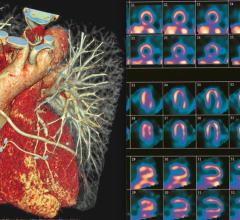
November 11, 2015 — Imaging tests of obese children — some as young as 8 years old — showed signs of significant heart disease and heart muscle abnormalities, according to research presented at the American Heart Association’s Scientific Sessions 2015.
Comparing 20 obese kids with 20 normal-weight kids, researchers found that obesity was linked to 27 percent more muscle mass in the left ventricle of their hearts and 12 percent thicker heart muscles – both signs of heart disease.
Forty percent of the obese children were considered “high-risk” because of problems with the thickened muscle in the heart, which were associated with impaired pumping ability. None of the children in the study showed physical symptoms, but researchers caution that heart problems during childhood may lead to more complicated health conditions in adulthood as well as premature death from heart disease.
“Parents should be highly motivated to help their children maintain a healthy weight,” said Linyuan Jing, Ph.D., lead study author and a researcher at Geisinger Health System in Danville, Pennsylvania. “Ultimately we hope that the effects we see in the hearts of these children are reversible; however, it is possible that there could be permanent damage. This should be further motivation for parents to help children lead a healthy lifestyle.”
Jing and colleagues measured a child’s obesity based on U.S. Centers for Disease Control and Prevention standard growth charts. Pediatric obesity is determined by whether a child’s body mass Index — a calculation derived from a child’s height and weight — exceeds the 95th percentile.
Of the 20 obese children, seven were teenagers. Among those seven teens, five had a body mass index over 35 (the healthy range varies for children but is 18.5-25 for adults). Some of the obese kids had conditions associated with excess weight, including asthma, high blood pressure and depression. All 40 children — obese and normal-weight — underwent magnetic resonance imaging (MRI) tests so that researchers could measure the function and dimensions of their hearts.
Researchers excluded children with diabetes and those who were too large to fit into the MRI machine to have measurements taken of their heart. “As a result, this means the actual burden of heart disease in obese children may have been underestimated in our study because the largest kids who may have been the most severely affected could not be enrolled,” Jing said. Researchers also noted that not all obese children in the study showed signs of heart disease.
An estimated one in three children ages two to 19 are either overweight or clinically obese, putting them at a greater risk for diabetes, high cholesterol and high blood pressure. The typical American diet for children has been cited as a contributor to the problem, with French fries accounting for 25 percent of a child’s vegetable intake and fruit juice, which is often high in sugar but low in fiber, accounting for 40 percent of a child’s fruit intake. Lack of regular physical activity and high amounts of screen time in front of televisions and computers has also been cited as an issue for children’s health.
Despite childhood obesity being a common problem, researchers were surprised to see evidence of heart disease among those as young as eight years old.
“This implies that obese children even younger than eight years old likely have signs of heart disease too,” Jing said. “This was alarming to us. Understanding the long-term ramifications of this will be critical as we deal with the impact of the pediatric obesity epidemic.”
Co-authors are Cassi M. Friday, M.S.; Jonathan D. Suever, Ph.D.; Nivedita Umasankar, B.S.; Christopher M. Haggerty, Ph.D.; Gregory J. Wehner, B.S.; Sean M. Hamlet, M.S.; David K. Powell, Ph.D.; Aurelia Radulescu, M.D.; H. Lester Kirchner, Ph.D.; Frederick H. Epstein, Ph.D.; and Brandon K. Fornwalt, M.D., Ph.D. Author disclosures are on the manuscript.
The study was funded by the National Institutes of Health and by the American Heart Association Great Rivers Affiliate.
For more information: www.scientificsessions.org


 January 23, 2024
January 23, 2024 








